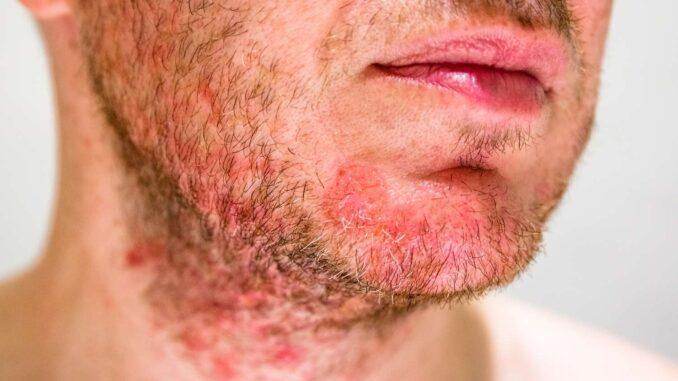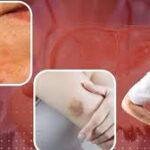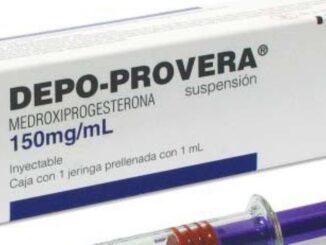
Last Updated on by lizzy
Dermatitis is a general term that refers to inflammation of the skin. It can be caused by various factors, including irritants, allergens, infections, and underlying skin conditions. The term dermatitis is often used interchangeably with eczema, although eczema specifically refers to a chronic and recurring type of dermatitis.

Types Dermatitis
Atopic Dermatitis
Also known as eczema, is a chronic and relapsing inflammatory skin condition. Typically begins in childhood and is characterized by dry, itchy, and inflamed skin.
Seborrheic Dermatitis
Affects areas such as the scalp, face and chest. It is characterized by redness, greasy or scaly patches, and dandruff-like flakes.
Nummular Dermatitis
Presents as coin-shaped or oval patches of red, itchy, and scaly skin. It is often triggered by dry skin, winter weather, or frequent exposure to water. The condition may be chronic and recurrent.
Dyshidrotic Dermatitis
Primarily affects the hands and feet, causing small, itchy blisters. These blisters can be painful and may lead to peeling, cracking, or thickening of the skin.
Allergic Contact Dermatitis
It is caused by an immune reaction to a particular allergen. Common allergens include metals (nickel, cobalt), fragrances, preservatives, certain plants (poison ivy, poison oak), and medications applied topically.
Irritant Contact Dermatitis
Occurs when the skin comes into contact with irritants that directly damage or irritate the skin. These irritants can include chemicals, detergents, acids, alkalis, solvents, or even prolonged exposure to water.
What Causes Dermatitis
- Exposure to certain substances or chemicals can irritate the skin
- Allergic contact of the skin with a substance that the immune system perceives as harmful.
- Genetic Factors: Some individuals have a genetic predisposition to developing the condition.
- Immune System Abnormalities: Atopic dermatitis (eczema), is considered to be an immune-mediated condition.
- Underlying Skin Conditions: Certain underlying skin conditions can contribute to the development of the condition.
- Infections: Can also be triggered or exacerbated by infections.
- Environmental factors like exposure to extreme temperatures, humidity levels, pollution, or dry air, which can affect the skin.
Symptoms Dermatitis
- Itching (pruritus): It can range from mild to severe and can be persistent or intermittent.
- Redness (erythema): Inflamed areas of the skin affected often appear red or flushed.
- Rash: Often presents with a rash, which can manifest as red patches, bumps, or blisters.
- Dry or flaky skin: Cause dryness and flakiness of the skin. The affected skin may feel rough, scaly, or have a peeling appearance.
- Swelling: Swelling may contribute to a sense of tightness or discomfort.
- Pain or tenderness: Particularly if the skin becomes cracked, blistered, or ulcerated.
- Blisters or vesicles: These fluid-filled bumps can be itchy, painful, or cause a burning sensation.
- Crusting or oozing: May result in the formation of crusts or the oozing of fluid from the affected skin.
- Thickened or leathery skin: Chronic or long-standing dermatitis can cause the skin to thicken and become leathery in appearance.
Eczema Treatment
Avoiding Triggers
Identifying and avoiding triggers that worsen the symptoms is essential. This may include avoiding specific irritants, allergens, or environmental factors that aggravate the condition. Understanding personal triggers and making necessary lifestyle or environmental modifications can help prevent flare-ups.
Skincare and Hygiene
Practicing good skincare and hygiene habits is crucial for managing dermatitis. This includes:
Topical Medications
- Gentle Cleansing: Use mild, fragrance-free cleansers and avoid hot water, which can further dry out the skin. Pat the skin dry gently after washing.
- Moisturizing: Regularly apply moisturizers or emollients to keep the skin hydrated and maintain its barrier function. Choose fragrance-free and hypoallergenic moisturizers, and apply them after bathing or showering while the skin is still damp.
- Bathing/Showering: Limit bathing or showering time and use lukewarm water. Avoid harsh soaps, bubble baths, and body washes that can strip the skin of natural oils.
Antihistamines
Oral antihistamines can help relieve itching and reduce inflammation associated with dermatitis. They may be recommended, especially when itching disrupts sleep or is severe.
Wet Wrap Therapy
Wet wrap therapy involves applying moisturizer and then damp bandages or clothing to the affected areas. This technique helps to increase skin hydration, enhance the absorption of topical medications, and provide relief during severe flare-ups. Wet wrap therapy should be done under medical supervision.
Phototherapy
In some cases, controlled exposure to specific wavelengths of ultraviolet (UV) light, known as phototherapy or light therapy, may be beneficial. Phototherapy can help reduce inflammation and itching in dermatitis, but it should be administered under medical supervision.
Medications
Oral medications such as oral corticosteroids or immunosuppressants may be prescribed.
These medications are typically reserved for short-term use due to potential side effects and require close monitoring by a healthcare professional.






Leave a Reply